Welcome to our blog post on High-Density Almond Plantation! Are you interested in learning about the innovative techniques, optimal spacing, and impressive yields associated with this modern approach to almond cultivation? We’ll delve into the fascinating world of high-density almond plantations, covering crucial aspects such as spacing, the number of plants per acre, advanced techniques, costs, and impressive yields.
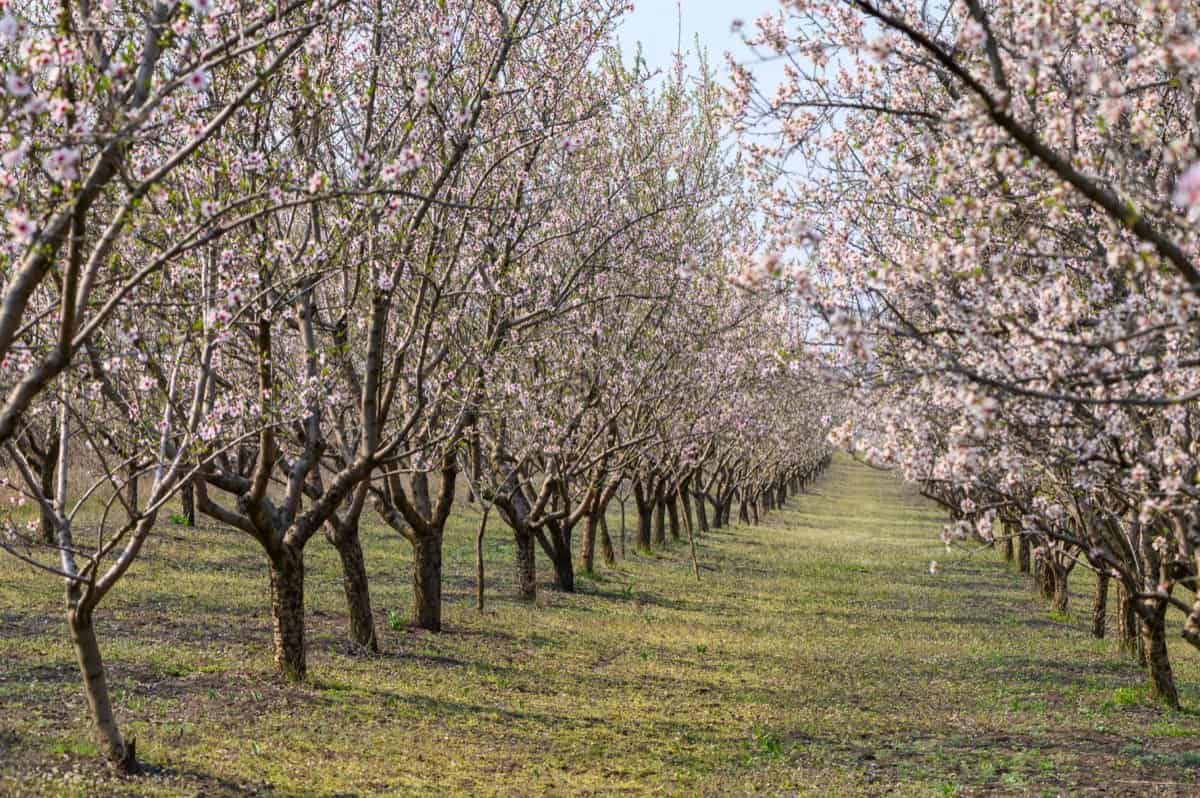
Get ready to discover the benefits of maximizing land use efficiency, effective pest management strategies, and optimal fertilization methods. We’ll also explore the challenges, market trends, and sustainable practices in high density almond plantation below.
What is High-Density Almond Plantation?
A high-density almond plantation is a modern approach to almond farming that aims to maximize land utilization while increasing overall yield. In this method, almond trees are planted at a closer spacing compared to traditional orchards. More trees can be planted per acre by utilizing techniques such as double-row planting and hedge-row systems, resulting in higher production capacity.
The closer spacing promotes healthy resource competition, leading to vigorous growth and improved fruit production. With high-density almond plantations, farmers can achieve greater efficiency, optimize their land use, and ultimately boost their almond yields for a more productive and profitable farming operation.
Benefits of High-Density Almond Plantation
- Increased Yield: High-density planting allows for more almond trees per acre, resulting in higher yield. The close spacing promotes competition among the trees, improving pollination, fruit set, and increased production.
- Efficient Land Use: Farmers can maximize their land’s potential by utilizing space more effectively and cultivating more almond trees. This is especially valuable in regions where land availability is limited or expensive.
- Enhanced Resource Utilization: High-density plantations enable efficient use of resources such as sunlight, water, and nutrients. The close spacing allows for better light interception, optimizing photosynthesis and tree growth. Additionally, irrigation and fertilization practices can be more precisely targeted to individual trees.
- Early Production: Due to the higher tree density, high-density almond plantations can reach productive stages earlier than traditional orchards. This means farmers can start harvesting and generating income sooner.
- Ease of Management: With trees in close proximity, orchard management tasks like pruning, pest control, and harvesting become more efficient and streamlined.
- Improved Pollination: The proximity of almond trees in high-density plantations enhances cross-pollination, leading to better fruit sets and more uniform nut development.
- Potential for Higher Profits: Increased yield, efficient resource utilization, and early production can increase profits for almond farmers in high-density plantations.
In case you missed it: Almond Farming/Production in the USA: How to Start, A Step-by-step Guide to Planting to Harvesting for Beginners
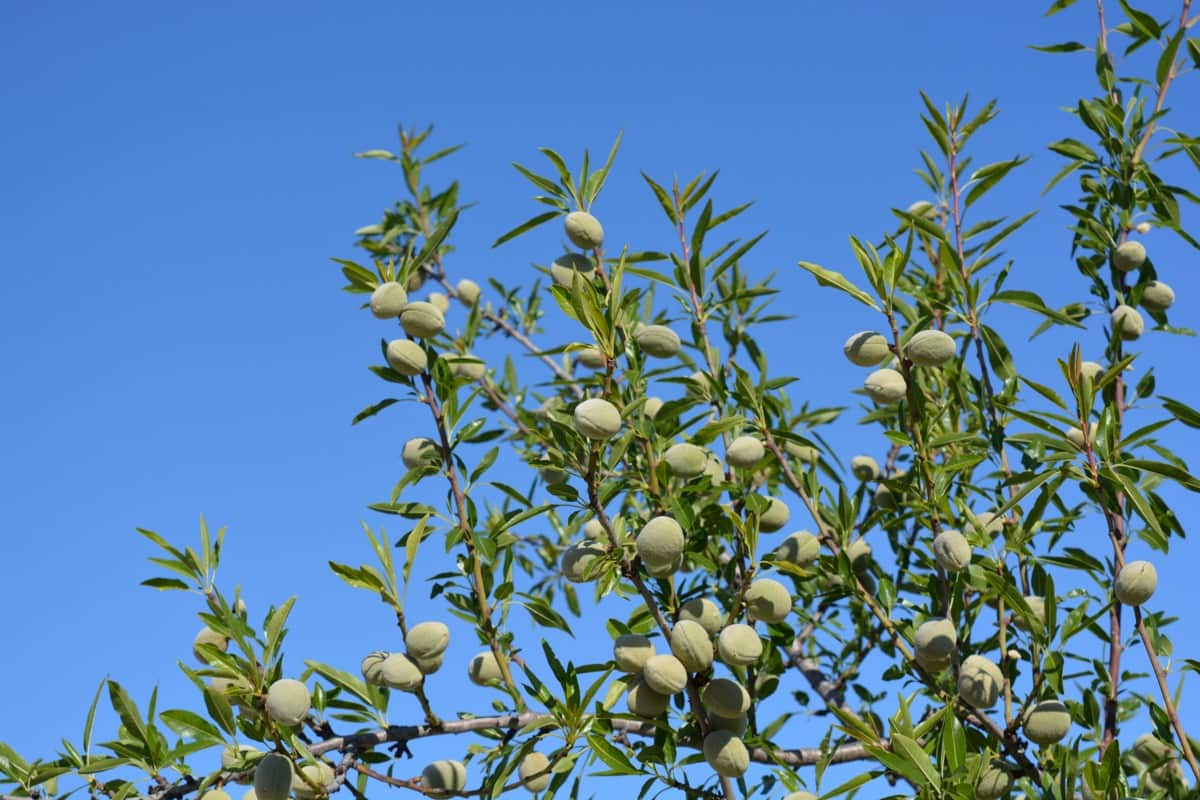
High Density Almond Plantation Techniques
- Tree Spacing: High-density plantations typically involve closer tree spacing, such as 15 feet between rows and 20-24 inches between trees within a row. This maximizes land use and promotes efficient resource utilization.
- Double-Row Planting: Planting two parallel rows of almond trees with a shared central alley is common in high-density plantations. This increases tree density while allowing access to equipment and sunlight penetration.
- Hedge-Row Systems: In this technique, almond trees are trained to form narrow hedges, creating a wall-like structure. It promotes vertical growth, simplifies pruning and harvesting, and maximizes sunlight interception.
- Trellising: Trellis systems support tree structure and promote upright growth. This technique helps maintain tree shape, facilitates canopy management, and improves sunlight penetration.
- Rootstock Selection: Appropriate rootstock selection is crucial for high-density plantations. Dwarfing or semi-dwarfing rootstocks are preferred to control tree size, increase planting density, and facilitate efficient orchard management.
- Pruning and Training: Regular pruning and training methods, such as hedging and topping, control tree height, encourage lateral branching, and maintain desired tree form.
- Canopy Management: Canopy manipulation techniques, such as limb bending or tying, optimize sunlight distribution within the orchard and improve air circulation.
- Irrigation and Nutrient Management: Precise irrigation systems, such as micro-sprinklers or drip irrigation, provide targeted water supply to individual trees. Nutrient management practices are tailored to meet the specific needs of high-density plantations.
High Density Almond Plantation Varieties
High-density almond plantations offer a diverse selection of commercially viable varieties. The Nonpareil variety, widely cultivated in California, is highly sought-after due to its abundant yield, nutty flavor, crunchy texture, and medium-sized kernels. Neplus is an excellent pollinator with its large nuts, dark brown skin, and early blooming. Carmel, the second most important cultivar, produces high-quality nuts with longer, larger, dark brown kernels.
Peerless stands out with its attractive bisque-colored hard shell, small dark brown kernels, and delightful nutty taste. Price is popular for its slightly bitter yet nutty taste, while Butte resembles Padre in appearance and taste. Sonora boasts the largest kernels, smoother light-colored shells, and a fantastic nutty taste.
In case you missed it: Top 20 Steps to Boost Almond Yield: How to Increase Fruit Size, Quality, and Production
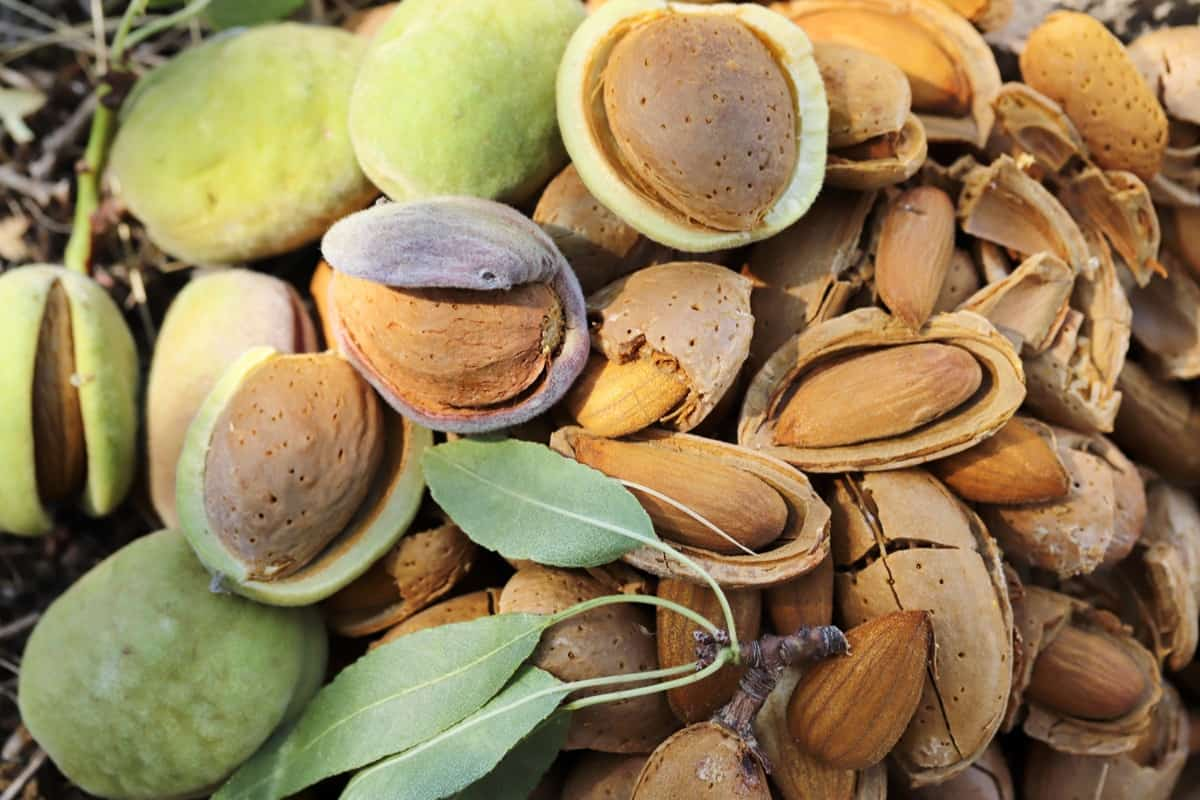
Monterey is highly productive, yielding larger kernels with a soft shell. Aldrich offers plump, medium-sized nuts with a mix of medium and hard shells. Various other cultivars are commercially grown, including Texas, Buttei, Thompson, Rudy, Carmel, California Mission Neplus, Um-el-Fahem, Hanatziv, Be’eri, Greek, and Marcona, each with unique qualities.
Increasing Yield in High Density Almond Plantation
Increasing yield in high-density almond plantations requires implementing key strategies such as proper spacing, improved pollination, balanced nutrition, efficient irrigation, pruning and training, and effective pest and disease management. Optimal spacing ensures adequate light, air circulation, and nutrient access. Enhancing pollination through interplanting and honeybee colonies boosts fruit set.
Balanced nutrition based on soil analysis promotes vigorous growth. Precise irrigation methods minimize water loss. Pruning and training maintain tree structure and optimize light penetration. Pest and disease management safeguards crop health. By employing these strategies, almond farmers can maximize yield, achieve productivity, and enhance profitability in high-density plantations.
Sustainable and Best Practices for High Density Almond Plantation
Suitable Climate Conditions: Almond trees thrive in moderate hot climates with temperatures ranging between 28 °C to 38 °C during the growing season. They require a cool winter period for proper kernel development. Almond blossoms are vulnerable to temperatures below 0 °C, so frost-prone areas should be avoided.
Soil Requirements: Almond trees prefer deep, loamy soil with good drainage. The ideal soil pH ranges from 6.8 to 8.5 for optimal growth and nut production. Heavy and poorly drained soils should be avoided.
Planting Methods: Almonds can be propagated through seeds or vegetative means. Seeds should be sown directly in well-prepared beds, and laminating the nuts before sowing promotes better germination. Rootstock propagation can also be used, but the resulting trees may have shorter lifespans. Planting should be done with proper spacing and support structures for wind protection.
Land Preparation: Thorough land preparation, including plowing and harrowing, ensures a fine tilth and removes weeds. Incorporating well-rotted farmyard manure improves soil fertility. Soil deficiencies should be addressed during land preparation.
Plantation and Spacing: Almond trees should be planted square or hexagonal, with spacing ranging from 2.5 to 6 meters, depending on the desired density. Planting pits should be prepared before planting season, and pollinizer cultivars should be strategically placed for effective cross-pollination.
Pollination: Almond trees are not self-pollinating, so a suitable pollinizer variety should be planted. Honey bee hives can be introduced during flowering to enhance pollination and fruit set.
In case you missed it: High-Density Litchi Plantation: Spacing, Plants Per Acre, Techniques, Cost, and Yield
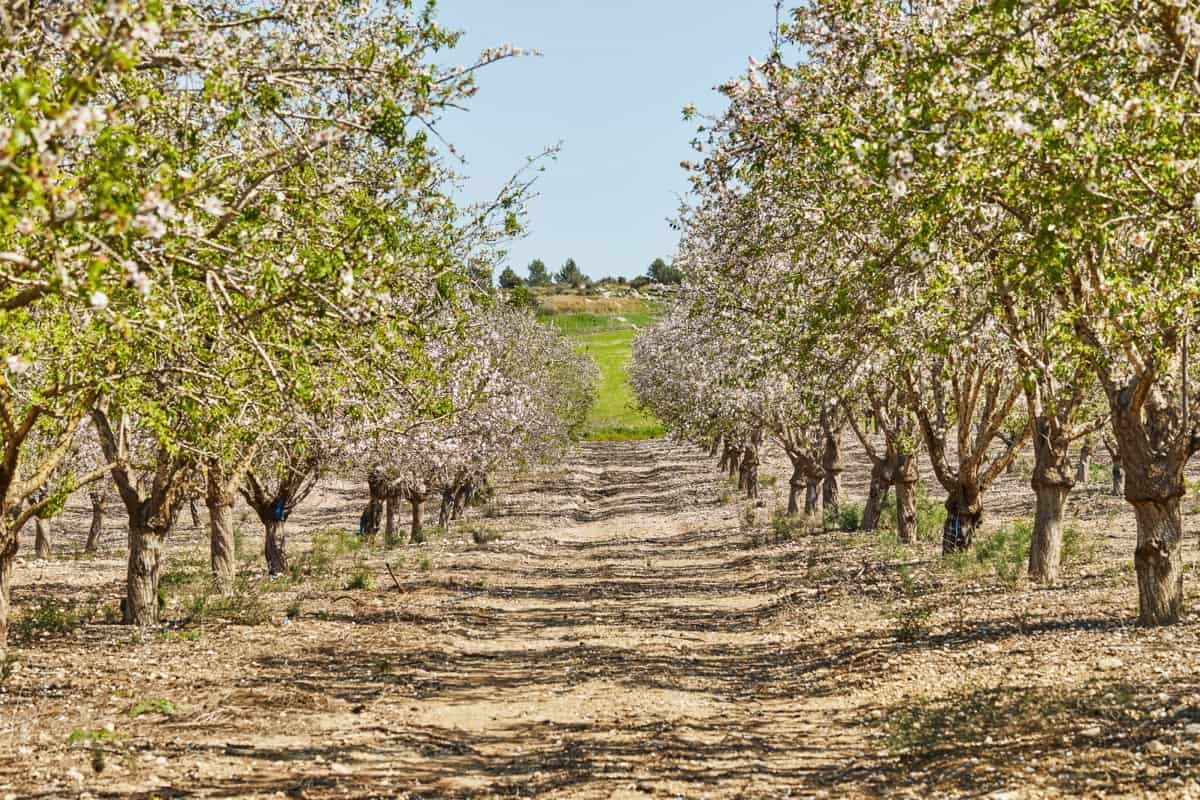
Frost Management: Early blossoming makes almond trees susceptible to frost damage. Protection measures, such as using micro-sprinklers for irrigation during frost events, can minimize crop loss.
Irrigation: Irrigation requirements vary based on climate and soil type, but drip irrigation is recommended for efficient water use. Proper drainage is crucial, as waterlogging can be detrimental to almond trees.
Fertilization: Almond trees are heavy feeders, and adequate fertilization is essential for optimal growth and yield. Soil testing helps determine nutrient deficiencies, and fertilizers should be applied accordingly. Nitrogen should be split into multiple doses, with foliar sprays of urea promoting fruit set and growth.
Pest and Disease Management: Common almond pests include aphids, borers, mites, and nematodes. Diseases like brown rot and silver leaf can also affect almond trees. Consultation with local horticulture departments is advised for proper identification and control measures.
Harvesting: Almonds are harvested when the shells split and the nuts dry. Tree shaking or manual harvesting methods are employed, and drying should be done in a shady area to maintain nut quality.
High Density Almond Plantation Spacing
High-density almond plantation spacing refers to the arrangement of almond trees in the orchard. In traditional systems, spacing is typically around 8×8 meters to 6×6 meters, with fewer than 350 trees per hectare. These systems often use vigorous rootstocks and need more mechanization and irrigation.
On the other hand, medium-high density systems have 250 to 700 trees per hectare, with spacings ranging from 6×4 meters to 5×3.6 meters. These systems employ medium to high levels of mechanization, including mechanized pruning and harvesting using pruners and trunk shaker harvesters.
Optimal Fertilization for High Density Almond Plantation
The average annual temperature for the almond plantation was 15.3 °C, with August being the hottest month (23.8 °C) and January being the coldest (7.8 °C). The soil was clay loam with a depth of 40 cm, providing adequate root expansion. Common practices were followed in the orchards, including drip lines and controlled irrigation, with an average seasonal irrigation volume of 3000 m3/ha. The annual fertilization of High-density almond plantations is 80 kg/ha of nitrogen (N), 40 kg/ha of phosphorus (P), and 80 kg/ha of potassium (K).
High Density Almond Plantation Pruning Methods
One-year-old almond trees were planted and trained using the central axis method. The manual pruning is planned for mid-May. Mechanical summer pruning was then conducted 2-3 times per season. Manual trimming between consecutive trees in the row occurred once a year during the first and second years.
The goal was to promote lateral branch growth and quickly fill the designated space for each tree. By the end of the second year, the trees had filled around 70% of the available volume. In subsequent years, mechanical topping, hedging, and trimming were performed before and after harvesting to adjust the tree canopy to the harvesting machine.
In case you missed it: Successful Pig Farm Management and Operational Strategies: A Complete Guide
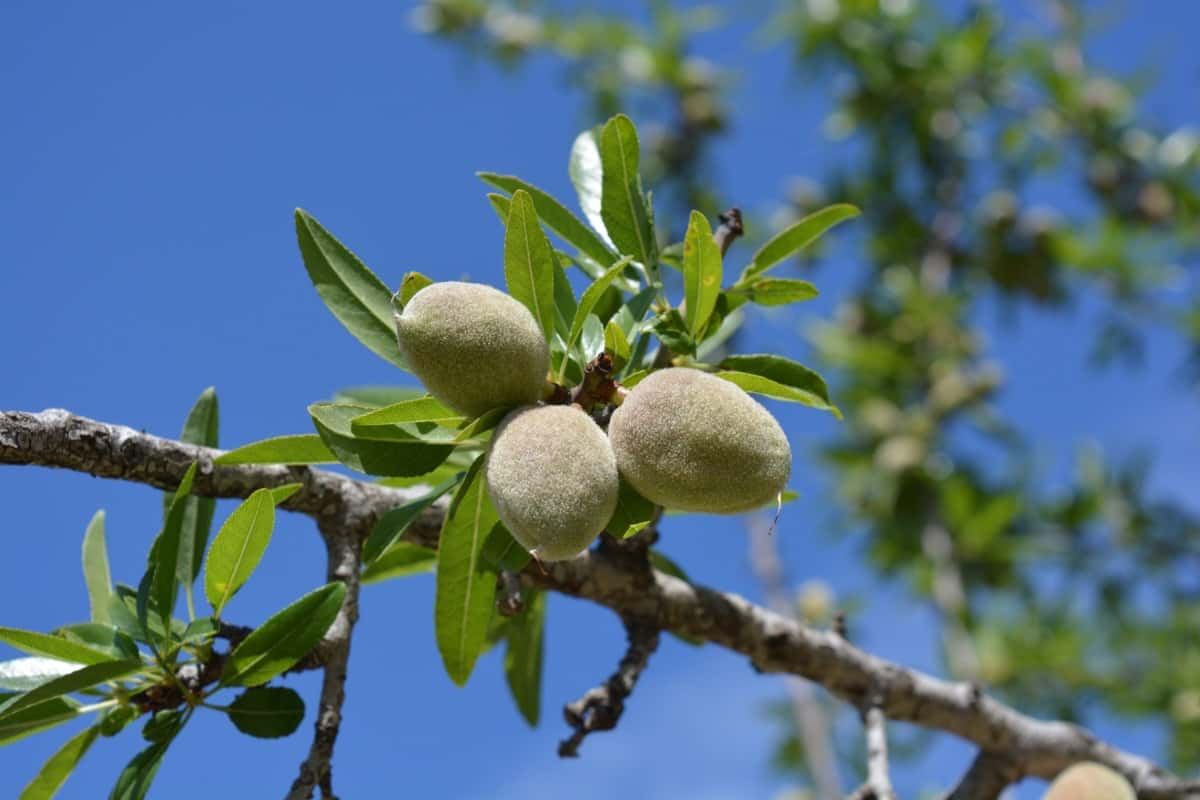
Managing Pests and Diseases in High Density Almond Plantations
In high-density almond plantations, effective management of pests and diseases is crucial for maintaining healthy trees and maximizing crop yield. Management practices can help protect almond trees in high-density plantations, ensuring healthy growth and optimal production.
- Leaf curling aphid: These insects cause the curling of leaves and withering of blossoms. Spray Chloropyriphos (0.02%), Thiometon (0.05%), or Methyldameton (0.025%) with Dimethoate (0.04%) at bud burst. Repeat the spray after ten days using malathion (0.03%) and endosulfan (0.04%).
- Sanjose scale: This scale attacks above-ground parts, leading to thin foliage and yellow speckling. Spray diesel oil emulsion in Potash-based fish oil soap (1:7) or tree spray oil during dormancy when nighttime temperatures are above 40°C.
- Chaffer beetle: Adult beetles feed on leaves, buds, blossoms, and fruit, while their grubs damage roots, causing wilting. Implement cultural practices to discourage beetle activity.
- Stem borer: These beetles drill holes in stems and branches, often accompanied by sawdust. Clean the holes, plug them with cotton soaked in petrol, then insert naphthalene balls. Monitor for further damage and repeat the procedure if needed.
- Shot hole/pinhole borer: These pests create pin-sized holes in the plant’s wood. Monitor for boring on the bark and take appropriate action if necessary.
- Leaf spot/shot hole: This disease causes small lesions on leaves, twigs, and fruits. Spray copper oxychloride 50wp (0.3%), Mancozeb 75 WP (0.25%), captan 50 WP (0.25%), or carbendazim 50 WP (0.05%) at specific stages of bud burst, petal fall, fruitlet, and post-fruitlet.
- Almond blight: This fungal disease forms dead lesions on young bark and wood. Regularly monitor for symptoms and promptly remove and destroy infected shoots.
- Leaf blotch: Yellow irregular blotches on leaves turn brick-red and form dark brown patches. Remove and destroy diseased leaves to prevent further spread.
- Blossom blight: This fungus infects buds, twigs, flowers, and young fruits. Monitor closely during wet weather conditions and take preventive measures such as pruning infected twigs.
High Density Almond Plantation Harvesting Tips
- Total mechanization from planting reduces costs and labor requirements.
- Fully mechanized harvesting with over-the-row machines increases speed and efficiency.
- Early entry into production (by year 3) leads to a faster return on investment.
- Reduced cultivation work and labor, addressing the scarcity and high labor cost.
- Improved fruit quality with minimized ground contact and reduced contamination risks.
- Increased crop profitability and sustainability due to lower inputs, reduced soil maintenance, efficient water and fertilizer use, and minimized dust generation during harvesting.
- Possibility of planting almond trees in shallow soils, which is not feasible with traditional systems.
High Density Almond Plantation Cost Analysis (1 Acre Basis)
| Category | Cost/Revenue (per acre) |
| Pre-Plant Costs | |
| Remove Irrigation System | $89 |
| Tree Removal/Chip | $1,200 |
| Spread Chips | $125 |
| Rip 3′ Depth/Root Removal | $250 |
| Rip 6′ Depth/Root Removal | $350 |
| Disc & Roll 2x | $130 |
| Laser Leveling | $75 |
| Survey Mark Site | $125 |
| Make Berms/Rows | $35 |
| Irrigation System Layout | $53 |
| Smooth/Float Row Middles | $35 |
| Strip Spray: Berms | $43 |
| Total Pre-Plant Costs | $2,511 |
| Planting Costs | |
| Treat Roots/Plant/Top (124 trees/acre) | $1,532 |
| Stake/Whitewash/Cartons/Irrigate-Hand | $313 |
| Total Planting Costs | $1,845 |
| Cultural Costs (per year) | |
| Irrigation, Fertilization, Pruning, Pest Control, Weed Control, etc. | $606 to $2,132 per year |
| Harvest Costs (per year) | |
| Shake Trees, Sweep Nuts, Hand Rake/Blow Nuts, Pick up/Haul Nuts, Hull/Shell Nuts | $253 to $405 per year |
| Operating Costs (per acre, including cultural and harvest costs) | $5,191 to $2,562 per year |
| Cash Overhead Costs (per year) | $398 |
| Total Cash Costs (per acre, including operating and cash overhead costs) | $5,589 to $3,042 per year |
| Non-Cash Overhead Costs (per year) | $1,441 |
| Total Costs (per acre for the year) | $7,030 to $5,149 per year |
| Revenue (per acre from production) | $1,000 to $5,000 per year |
| Net Profit (per acre above cash costs) | $693 to $1,958 per year |
In case you missed it: Arka Savi Rose Cultivation: Yield Per Acre, Growing Cost, and Profit Analysis
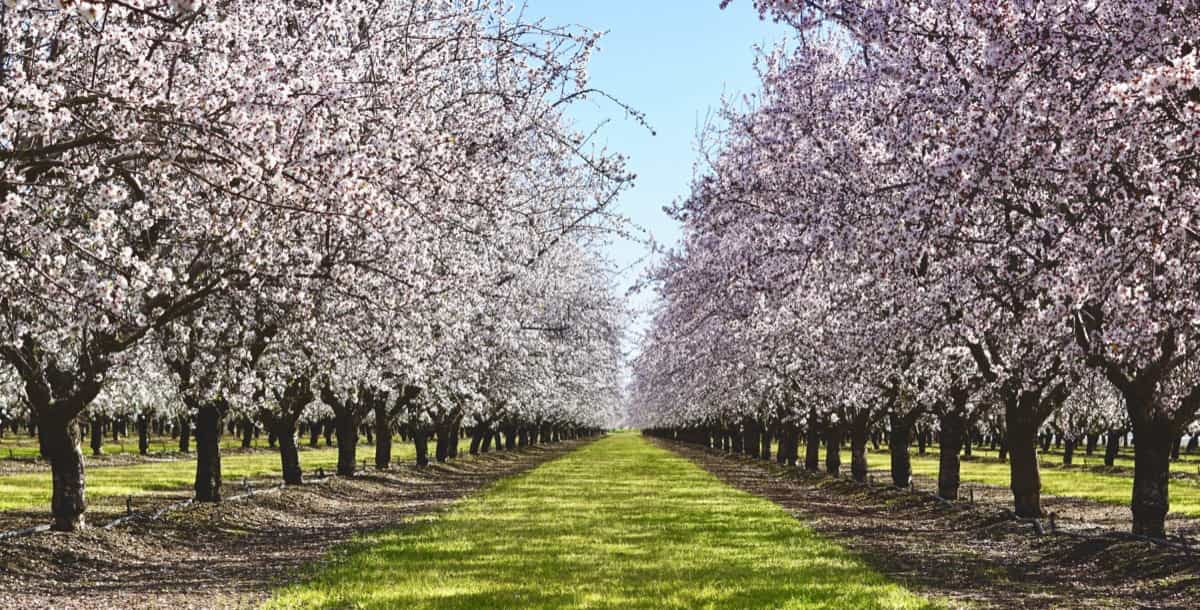
The pre-plant costs amount to $2,511 per acre, while the planting costs total $1,845 per acre. Cultural costs, including irrigation, fertilization, pruning, pest control, and weed control, vary from $606 to $2,132 per year. Harvest costs range from $253 to $405 per year. Operating costs, including cultural and harvest costs, range from $5,191 to $2,562 per year. Cash overhead costs are constant at $398 per year.
The total cash costs, including operating and cash overhead costs, range from $5,589 to $3,042 per year. Non-cash overhead costs are constant at $1,441 per year. The total costs per acre for the year range from $7,030 to $5,149. Revenue from production varies from $1,000 to $5,000 per year, resulting in net profits ranging from $693 to $1,958 per year.
Conclusion
High-density almond plantation involves a close spacing of trees, typically with 550-700 trees per acre. Planting techniques include root treatment and staking. Costs range from $7,030 to $5,149 per acre, while yields vary from $1,000 to $5,000 annually.
- Types of Pesticides Used in Agriculture: A Beginner’s Guide
- Economical Aquaculture: A Guide to Low-Budget Fish Farming
- 15 Common Planting Errors That Can Doom Your Fruit Trees
- How to Make Houseplants Bushy: Effective Tips and Ideas
- Innovative Strategies for Boosting Coconut Pollination and Yield
- Pollination Strategies for Maximum Pumpkin Yield
- The Complete Guide to Chicken Fattening: Strategies for Maximum Growth
- Natural Solutions for Tulip Problems: 100% Effective Remedies for Leaf and Bulb-Related Issues
- Revolutionizing Citrus Preservation: Towards a Healthier, Greener Future
- Natural Solutions for Peony Leaf and Flower Problems: 100% Effective Remedies
- Maximizing Profits with Avocado Contract Farming in India: A Comprehensive Guide
- Natural Solutions for Hydrangea Problems: 100% Effective Remedies for Leaf and Flowers
- The Ultimate Guide to Choosing the Perfect Foliage Friend: Bringing Life Indoors
- From Sunlight to Sustainability: 15 Ways to Use Solar Technology in Agriculture
- The Ultimate Guide to Dong Tao Chicken: Exploring from History to Raising
- The Eco-Friendly Makeover: How to Convert Your Unused Swimming Pool into a Fish Pond
- Mastering the Art of Delaware Chicken Farming: Essentials for Healthy Backyard Flocks
- 20 Best Homemade Fertilizers for Money Plant: DIY Recipes and Application Methods
- How to Craft a Comprehensive Free-Range Chicken Farming Business Plan
- Brighten Your Flock: Raising Easter Egger Chickens for Beauty and Bounty
- How to Optimize Your Poultry Egg Farm Business Plan with These Strategies
- Subsidy for Spirulina Cultivation: How Indian Government Schemes Encouraging Spirulina Farmers
- Ultimate Guide to Raising Dominique Chickens: Breeding, Feeding, Egg-Production, and Care
- Mastering the Art of Raising Jersey Giant Chickens: Care, Feeding, and More
- Ultimate Guide to Raising Legbar Chickens: Breeding, Farming Practices, Diet, Egg-Production
- How to Raise Welsummer Chickens: A Comprehensive Guide for Beginners
- How to Protect Indoor Plants in Winter: A Comprehensive Guide
- Ultimate Guide to Grow Bag Gardening: Tips, Tricks, and Planting Ideas for Urban Gardeners
- Guide to Lotus Cultivation: How to Propagate, Plant, Grow, Care, Cost, and Profit
- Agriculture Drone Subsidy Scheme: Government Kisan Subsidy, License, and How to Apply Online
- Ultimate Guide to Raising Araucana Chickens: Breed Profile, Farming Economics, Diet, and Care
- Bringing Hydroponics to Classroom: Importance, Benefits of Learning for School Students
- Ultimate Guide to Raising Polish Chickens: Breed Profile, Farming Economics, Diet, and Care
- Ultimate Guide to Raising Australorp Chickens: Profile, Farming Economics, Egg Production, Diet, and Care
- Silkie Chicken Farming: Raising Practices, Varieties, Egg Production, Diet, and Care
- Sussex Chicken Farming: Raising Practices, Varieties, Egg Production, Diet and Care